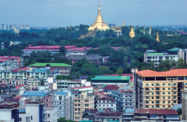In a year marked by a return to full civilian rule, Myanmar’s economy continued to expand strongly, though some sectors saw slower growth as reduced foreign investment and a weaker currency eroded some gains.

Transition of power
Having won an absolute majority in the November 2015 general election, the National League of Democracy (NLD) installed U Htin Kyaw as its candidate for presidency following a parliamentary vote at the end of March.
The transition to the new administration was smooth, with the hand-over of power by the military-backed Union Solidarity and Development Party seen as a sign of the country’s maturing democracy.
Upon entering office, the new NLD-led government inherited an economy that was expanding rapidly but unevenly, while still being affected by some sanctions that had been imposed during the years of military rule.
Mixed indicators
An IMF Article IV consultation issued in October found that growth had eased somewhat in the first half of FY 2016/17, which started on April 1. This was due to a downturn in returns in the real estate market, an adjustment in the construction sector, slowing demand from major trading partners and weak commodity prices.
Having reached a record $9.5bn worth in FY 2015/16, foreign direct investment (FDI) decreased by 65% year-on-year (y-o-y) to $3.3bn in December, according to the Directorate of Investment and Company Administration. However, FDI is widely expected to make a strong return to growth on the back of the lifting of US sanctions in the second half of 2016 and growing interest from China.
The prospect and eventual approval of an interest rate hike in the US put pressure on the local currency, with the kyat losing 14% of its value in the second half of 2016 against a strengthening dollar.
The currency’s dip helped fuel inflation and increased the costs of imports such as oil. Myanmar’s consumer price index rose by 8.26% y-o-y in October, leading the IMF to forecast a year-end rate of 9.8%.
The IMF predicts growth will fall to 6.5% this fiscal year, from 7.6% in FY 2015/16. Nonetheless, rising FDI and foreign aid are expected to help GDP rebound to 7.7% in both this calendar year and the next.
Gems of the economy
Some of the impetus for growth will come via the mining industry, which saw the lifting of US sanctions that had banned the importation of jade and rubies from Myanmar.
In repealing the sanctions on October 7, US President Barack Obama opened the door for gemstone sales to dealers in the US and removed concerns of other overseas traders who may have been hesitant to enter the Myanmar market for fear of falling foul of Washington.
The retail sector is also expected to benefit, with more overseas brands looking to cash in on Myanmar’s growing economy and broadening middle class.
Rising retail demand saw occupancy rates for shop space in Yangon top 90% in the third quarter, with new releases set to take floor space to 300,000 sq metres by year’s end, doubling the level recorded in 2013, according to real estate consultancy Colliers International.
Property oversupply
The correction in the property market highlighted by the IMF in its Article IV consultation led to decreases in sales and revenue up to and into the second half of 2016.
Much of this correction was in response to an oversupply in some segments, in particular at the top end of the market – over 6650 high-end residential units were left vacant at the beginning of the year, more than double the total figure for 2014, according to Colliers.
However, finalisation of new regulations that allow foreigners greater access to the property market and a gradual soaking up of excess supply may see the real estate sector become more buoyant in 2017.
Market trading begins
Myanmar’s stock market will also be looking to rebound in 2017, following a disappointing first year of operations.
On March 25 trading began on the Yangon Stock Exchange (YSX), though by the opening bell only one company had listed: First Myanmar Investment, focused on the financial services, real estate and health care sectors.
Since peaking at 1322.58 points back in late March, just days after trading opened, the YSX index has retreated steadily, falling to 617.13 in mid-December. Market capitalisation has also declined sharply from a high of MMK962.68bn ($703m) on March 30 to MMK582.92bn ($429.6m) as of December 30.
By the end of the year three companies had listed on the YSX’s boards, with another three preparing to list in 2017, though analysts had forecast that as many as 10 companies would be trading by the end of 2016.


